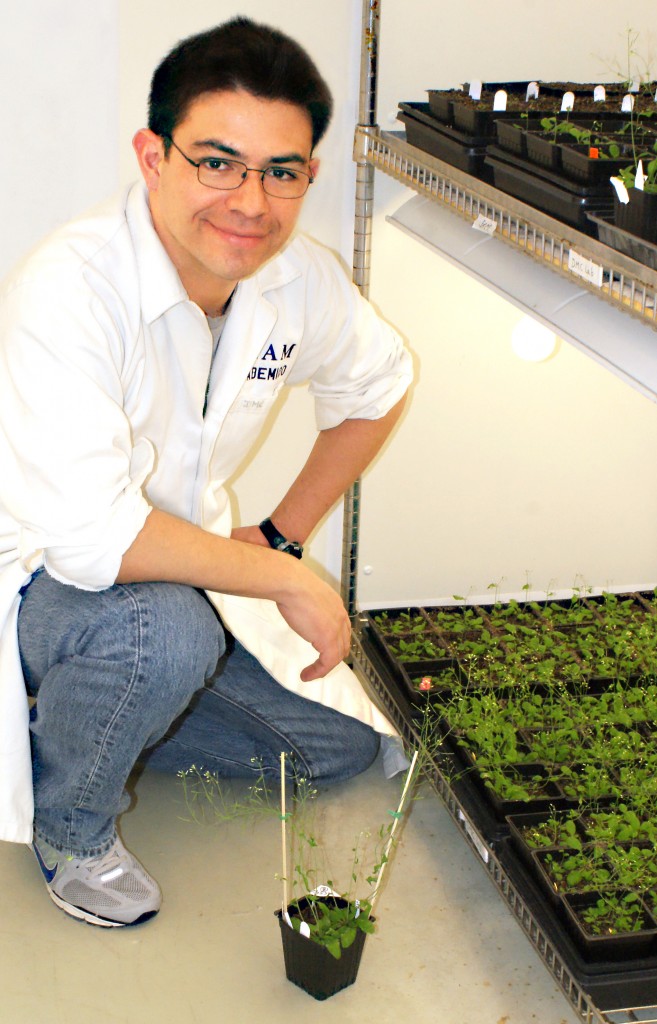
Courtesy Randy Mertens/CAFNR
Forget fruits and vegetables, seeds provide a critical part of the average person’s diet. From beans to cereal grains, understanding how genes and soil types impact nutrition could one day help produce more nutritious food.
One University of Missouri researcher wants to know which genes control the elements in these nutrient-rich packages.
“Iron and zinc deficiencies are considered two major nutritional disorders in the world, so there’s a lot of interest in developing plants with enhanced amounts of these micronutrients,” said David Mendoza-Cozatl, a Bond Life Sciences Center plant scientist. “The question for labs like mine is how can you convince a plant to accumulate more of these metals even though high concentrations can be toxic to plants?”
In a five-year collaboration with researchers at the University of Nevada and UC San Diego, the group measured the amounts of 14 elements in both plant seeds and leaves of mutant Arabidopsis thaliana plants planted in different soil types (salty, alkali, heavy metal and normal).
These mutants were special. Each plant had a different gene disabled, allowing researchers to tell if the disabled gene affected uptake of minerals into the seeds or leaves.
The teams found that 11 percent of genes influence proteins relevant to the nutritional content in seeds. Soil types also played a role in the significance each gene’s impact.
The approach could be likened to understanding how a car works.
“What we are doing here is we have a car with different parts missing, and the question we are asking is what happens to the car without each of these parts,” Mendoza-Cozatl said. “In plants we ask how more or less elements or nutrients can accumulate without each of these parts, these genes. That’s how we are trying to assign the function of a gene to nutrient homeostasis.”
Mendoza-Cozatl’s work with the group focused on soil laced with non-essential heavy metals (e.g. cadmium and arsenic). They grew mutant plants from seeds and compared nutrient content of those plants’ leaves and seeds to a baseline. To do this, researchers “digested” leaves and seeds, separately, then quantified the amounts of elements.
“We turn everything into basic elements by putting the seeds or leaves in a tube, adding nitric acid and boiling them,” Mendoza Cozatl said. “We found that the mineral makeup of the seed and leaves can be different.”
This surprised him since nutrients in seeds come through the leaves via the phloem. The phloem is living tissue that transports nutrients throughout a plant.
Nutrition isn’t the only area that could benefit from knowing what controls the transport of minerals in plants.
A newly engineered plant could be made to use less fertilizer or move particular types of minerals, like toxic heavy metals.
“Many former industrial areas contain fields contaminated with heavy metals like cadmium and arsenic,” Mendoza-Cozatl said. “Understanding genes important to nutrient transport could help both with bioremediation in soil and bio fortification in food.”
Genes identified through this study will lead to new research in the Mendoza lab as well as other labs involved in this large project.
“The mechanism underlying these changes in nutrient seed composition are not known, so we still need to find how these genes are affecting the seed composition,” Mendoza said. “That’s where the advance will be more significant, and we’re not there quite yet.”
A grant from the National Science Foundation funded this research. Mendoza-Cozatl is an assistant professor of plant sciences in MU’s College of Agriculture, Food and Natural Resources and a member of MU’s Interdisciplinary Plant Group.
Read details about the research in the science journal PLOS ONE.

